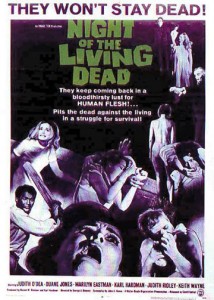.
In March of 1972 the Union of Soviet Socialist Republics launched a pair of space probes bound for the planet Venus. One of those probes suffered a failure of either an engine quitting too soon or not producing enough thrust. Either way was the probe failed to escape orbit about the Earth and has spent the last 53 years in an inclined and eccentric orbit that has very slowly degraded. Sometime tomorrow, May 10th, 2025, it will pass too deep in the Earth’s atmosphere, lose too much velocity, and return to its planet of origin with the very solidly built lander possibly surviving all the way down to impact.
What does this have to do with Pittsburgh filmmaker George A. Romero?
While Romero directed 17 feature films before his passing in 2017 and was involved in both film and television projects, he is best known for the creation of the modern cinematic zombie with 1968’s Night of the Living Dead.
 In Night the recently deceased are reanimated to attack and consume the living. The film, with a budget of about the same value as a single episode of the original series of Star Trek, focused on a disparate group of fractious survivors attempting to outlive a siege of the dead there are moments here and there where the larger world of the story is revealed. One of those moments provides a usual bad scientific ‘explanation’ for the plague of ghouls. (It’s worth noting that the word ‘zombie’ is not uttered in what many consider to be the birth of the modern zombie genre.) That explanation is that a Venus probe returning to Earth with a strange and unknown radiation has ‘activated’ the brains of the dead causing them to reanimate. Later movies in the series would ignore that origins of the monsters preferring no solid answers, but the original film remains with its foreboding prediction of death from returning probes that had been bound for Venus.
In Night the recently deceased are reanimated to attack and consume the living. The film, with a budget of about the same value as a single episode of the original series of Star Trek, focused on a disparate group of fractious survivors attempting to outlive a siege of the dead there are moments here and there where the larger world of the story is revealed. One of those moments provides a usual bad scientific ‘explanation’ for the plague of ghouls. (It’s worth noting that the word ‘zombie’ is not uttered in what many consider to be the birth of the modern zombie genre.) That explanation is that a Venus probe returning to Earth with a strange and unknown radiation has ‘activated’ the brains of the dead causing them to reanimate. Later movies in the series would ignore that origins of the monsters preferring no solid answers, but the original film remains with its foreboding prediction of death from returning probes that had been bound for Venus.
Of course, there is no danger of zombie and the end of the world from the old piece of communist hardware returning to Earth, but I find the coincidences amusing.
